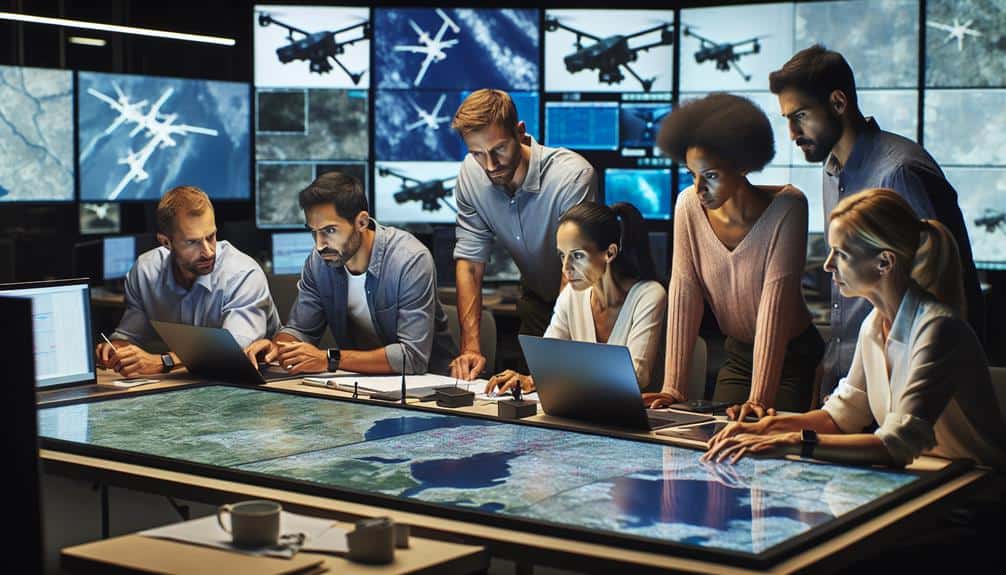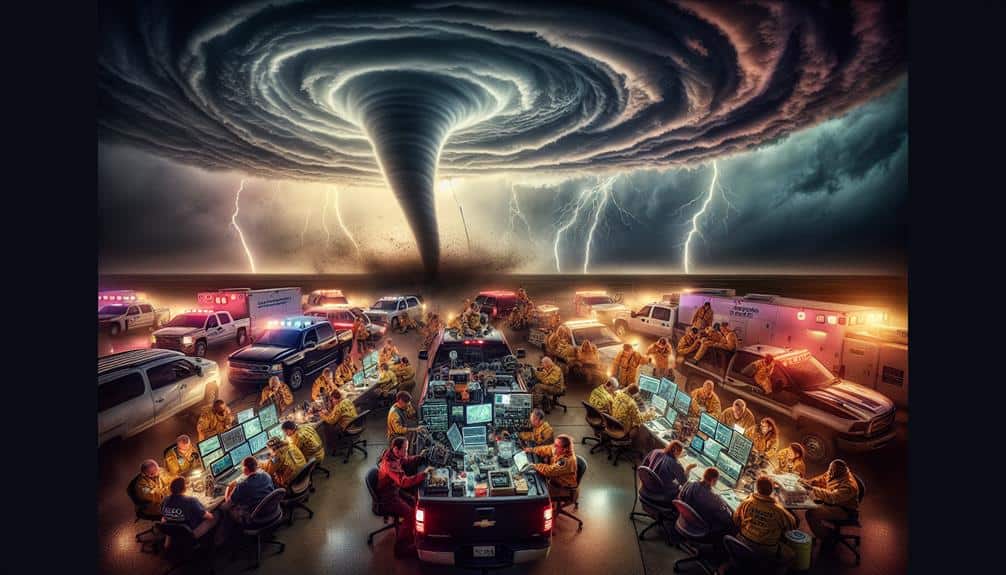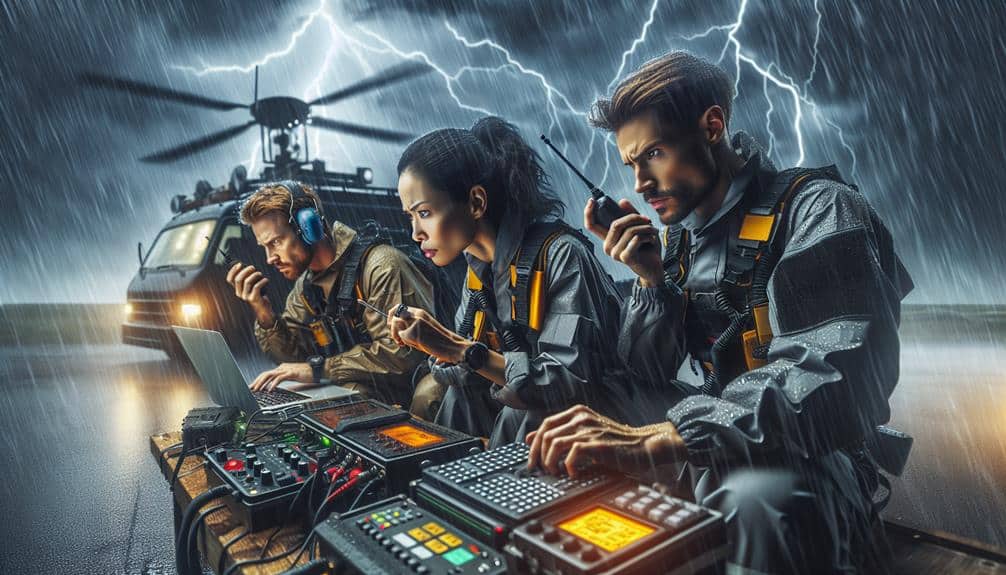We optimize search and rescue operations by integrating advanced technology, effective communication, and strategic resource allocation. Utilizing drone surveillance, GPS tracking, and thermal imaging enhances our situational awareness. We guarantee seamless real-time updates through radios and satellite phones. Predictive analytics help us deploy resources where they are most needed, while simulation exercises and cross-disciplinary drills prepare our teams for all scenarios. Post-operation analyses offer critical insights for continuous improvement. Leveraging these strategies maximizes our operational efficiency and readiness to respond. To uncover deeper insights into each optimization technique, exploring further details would be beneficial.
Key Points
- Utilize drone surveillance and GPS tracking for real-time monitoring and efficient resource deployment.
- Ensure effective communication channels with integrated tools like radios and satellite phones for timely information exchange.
- Conduct regular training and simulation drills to enhance team readiness and practical experience.
- Allocate resources strategically using predictive analytics to anticipate high-risk areas.
Effective Communication Channels
Effective communication channels are crucial for coordinating search and rescue operations efficiently. In emergency response scenarios, timely information exchange can mean the difference between life and death. We need to guarantee that our teams have access to reliable communication networks that facilitate real-time updates. This enables us to adapt swiftly to changing conditions and make informed decisions on the fly.
By integrating various communication tools—such as radios, satellite phones, and digital messaging platforms—we can maintain a constant flow of information. This redundancy ensures that if one channel fails, others can back it up, keeping our operations running smoothly. Real-time updates allow us to monitor the situation continuously and allocate resources where they're needed most.
Moreover, effective communication channels help us coordinate with other agencies, ensuring a unified and coherent response. We can share critical data, such as personnel locations, resource availability, and environmental conditions, thereby enhancing our operational efficiency. When we streamline information flow, we can reduce response times and increase the likelihood of successful rescues.
Technology Integration
Building on our robust communication infrastructure, we must integrate advanced technologies to enhance the efficiency and effectiveness of our search and rescue operations. By leveraging tools such as drone surveillance and GPS tracking, we can cover larger areas more swiftly and accurately, ensuring timely assistance for those in need.
Drone surveillance provides us with real-time, high-resolution aerial imagery, enabling us to quickly identify hazardous zones and locate survivors. These drones can operate in adverse conditions where ground teams might struggle, thereby increasing our operational reach and safety.
Additionally, GPS tracking allows us to monitor the movements of both our rescue teams and the individuals we're trying to locate, ensuring precise coordination and reducing response times.
Key technologies to integrate include:
- Drone Surveillance: Real-time aerial imagery for hazard identification and survivor location.
- GPS Tracking: Accurate monitoring of rescue teams and individuals in need.
- Thermal Imaging Cameras: Enhanced visibility in low-light or obstructed environments.
- Geospatial Information Systems (GIS): Advanced mapping for terrain analysis and route optimization.
Resource Allocation
To maximize the impact of our search and rescue operations, we must strategically allocate resources based on real-time data and predictive analytics. This approach guarantees that our staffing levels are ideal, allowing us to deploy teams efficiently where they're most needed.
By analyzing data on weather patterns, terrain, and previous incident reports, we can anticipate high-risk areas and pre-position our resources accordingly.
Effective equipment distribution is equally vital. Making sure that our teams have the right tools for diverse scenarios enhances operational efficiency. For example, distributing drones equipped with thermal imaging to areas with thick vegetation can greatly reduce search times. Additionally, ensuring that emergency supplies are readily available and strategically placed can make a substantial impact on the outcome of rescue missions.
Volunteer coordination is another essential aspect. Volunteers often bring unique skills and local knowledge that can be invaluable. By integrating them into our operations and providing clear instructions, we enhance our capabilities without overextending our professional teams. Utilizing a centralized system to manage volunteer efforts ensures that their contributions are impactful and well-directed.
Training and Drills
Guaranteeing our teams are well-equipped for any scenario, we prioritize rigorous training programs and thorough drills. Effective search and rescue (SAR) operations hinge on the proficiency of our personnel, which we achieve through a combination of simulation exercises and hands-on training. By simulating realistic emergency scenarios, we provide our teams with the experience necessary to make quick, informed decisions in high-pressure environments.
Our training regimen includes:
- Simulation exercises: These replicate real-world emergencies, allowing teams to practice coordination and rapid response.
- Hands-on training: Practical sessions where team members gain experience with equipment and techniques.
- Cross-disciplinary drills: Integrating various SAR elements such as medical response, technical rescue, and communication protocols.
- Scenario-based evaluations: Evaluating team performance in controlled yet unpredictable settings to identify areas for improvement.
We recognize that freedom in the field comes from meticulous preparation. Our analytical approach guarantees that every team member can operate autonomously yet cohesively, enhancing overall mission success.
Post-Operation Analysis

Following each mission, we conduct a thorough post-operation analysis to identify strengths and areas needing improvement. This analysis is essential for extracting lessons learned and facilitating operational improvements. By systematically reviewing our actions, we pinpoint what worked well and what didn't, allowing us to refine our strategies and tactics for future operations.
We start by debriefing all team members, ensuring that every perspective is heard. This collaborative approach helps us gather a detailed understanding of the mission.
We then analyze data from various sources, including GPS logs, communication transcripts, and incident reports. This data-driven assessment provides insights into the efficiency and effectiveness of our procedures.
Next, we focus on identifying key lessons learned. These could range from logistical challenges to gaps in communication protocols. We categorize these findings to streamline the process of implementing corrective actions.
For instance, if we find that our communication devices failed in certain terrains, we explore alternative technologies to mitigate this issue.
Frequently Asked Questions
How Do Environmental Conditions Affect Search and Rescue Operations?
Isn't it ironic how weather challenges and terrain obstacles dictate our search efforts? Effective resource allocation and communication methods become critical under adverse conditions, ensuring we operate efficiently and maintain our freedom to save lives.
What Are the Psychological Impacts on Search and Rescue Personnel?
We confront notable psychological impacts, including stress management and trauma response. Team support is essential for maintaining mental health. By prioritizing these aspects, we can guarantee our resilience and effectiveness in high-pressure situations.
How Do Search and Rescue Operations Differ in Urban Vs. Rural Settings?
Urban search and rescue leverages technology advancements and resource allocation efficiently, while rural operations rely on robust communication strategies and community engagement. We must adapt to diverse environments, ensuring effective responses and maximizing freedom in crisis.
What Role Do Volunteers Play in Search and Rescue Missions?
Volunteers play a vital role in search and rescue missions. Their training and coordination enhance operational efficiency. Community engagement and support foster a robust network, ensuring timely responses and maximizing resource allocation for effective rescues.
How Are Search and Rescue Dogs Trained for Emergency Situations?
We train search and rescue dogs using specialized canine training and emergency response techniques. Our dogs learn to navigate diverse environments, identify scents, and respond to commands, ensuring they're ready for rapid emergency deployment.


